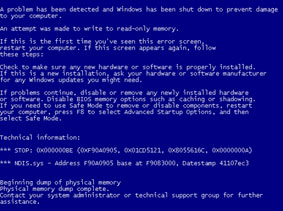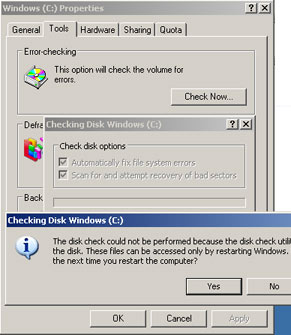Experience handling errors difficult to identify causes
 AUTOMATIC OPERATION
AUTOMATIC OPERATION
The phenomenon of computer restarting itself without error is the "headache" problem of many readers. The same phenomenon but due to many different causes: may be due to Windows error, conflicts between software, disputed hardware device drivers or poor quality, unstable hardware. This phenomenon occurs regardless of whether a newly purchased, newly assembled or second-hand machine is in use, only occasionally or continuously. Automatically restart when the computer is shutdown or at any time. At startup or when running applications that take up system resources .
Because they happen not to follow a rule at all, to determine the exact cause requires you to have replacement hardware, time and patience. In this case, we often use the right and wrong tests to degrade the causes that might cause the computer to restart automatically.
Testing software
Check the software if this happens after you modify the system, install or remove applications, software . (Note the actions that affect the system). For Windows 2000 / XP, log on as Administrator, go to Control Pannel Administrative ToolsEvent Viewew to see the error message. This is one of the places to consult, find out the cause to know how to overcome.
In case of necessity, download from the manufacturer's website and update the drivers of hardware devices such as chipsets, graphics cards, sound cards, network cards . You should choose the drivers compatible with the session. The operating system version is in use. See more information at www.microsoft.com/whdc/whql/default.mspx .
Default setting Windows NT / 2000 / XP will automatically restart the computer when there is an error related to the system (including during shutdown). A temporary solution is to turn off this feature, do the following:
+ Right-click on My Computer, select Properties to enter System Properties.
+ Select Advanced tab, in Start and Recovery, select Settings.
+ Uncheck the "Automatically Restart" option.
+ Click OK to confirm changes and restart.
Removing Automatically Restart option will cause the system to freeze or display "dead blue screen" when an error occurs (Figure 1). This will make it easier to identify the cause of the error. To fix it, reinstall Windows with the R (Repair) option so that Windows can fix the error itself. If you can't fix it by reinstalling, you should format the hard disk partition and install new Windows. For more information on how to install in Windows Refresh, the article "Windows Rejuvenation" (ID: A0305_103).
Hardware check
 Figure 1
Figure 1
We cannot (or dare not) intervene in hardware, modify or change software.Therefore, "replace and try" is the solution we use to determine the cause.In this case, RAM and power supply (Power Supply Unit - PSU) are two hardware you need to pay special attention to.
Practical experience shows that, with P3 system (or equivalent), RAM is the first hardware to test but for current P4 systems, the first hardware to check is the power supply.
RAM
Some software (free or paid) will help you check RAM like Memtest86 (www.memtest86.com), Gold Memory (www.goldmemory.cz). However, the use of test software will take a long time with high capacity RAM (512MB or 1GB). So "replace and try" will help you avoid "waiting" if there is replacement RAM available.
The source
 Figure 2
Figure 2
The power supply is an important hardware device, providing power to the entire system.However, the selection of power supplies has not been interested by users for a long time.With a host of new dual or "2 in 1" technologies like RAM dual channel, RAID hard disk, SLI / CrossFire graphics, dual monitor, dual core CPU . Power supply becomes more important than ever because It determines the stability of the system, the life of other hardware devices.This burden has exceeded the "tolerance" of unidentified sources on the market, including power supplies labeled 600 - 700W.Therefore, do not regret money when investing in the system's power supply because they avoid giving you unfortunate incidents when overloading occurs.For more information regarding the selection of a reasonable power supply in the "Solving Power Supply Problem (ID: A0505_131)" and the "Power Supply - Heavy Load PC" article (ID: A1205_56).
Note
- During the inspection process, you must note the problem of static electricity and grounding of the body to avoid causing damage to devices and components.
- Back up important data to avoid loss when checking.
- Hardware testing requires expertise and experience, if possible, ask an experienced person for help.
- The fluctuating voltage is also the cause of unstable computers. Too high or too low voltage may damage the hardware device. If possible, you should be on a voltage stabilizer or better than UPS for your "sweetie".
XP ALWAYS CHECK HARD
It is frustrating when Windows XP always runs checkdisk (similar to Win98's scandisk) every time you boot up even if you have turned it off properly. If you don't want to be annoying, you can turn off this feature; however, you must make sure that the system still works (except to always run checkdisk). Before using this solution, we try to do some of the following.
- First of all, you check the applications that automatically run in Scheduled Tasks. Select Start, Programs, Accessories, System Tools, Scheduled Task to see which programs are using this feature. Delete everything related to Chkdsk or Autochk.
- Perform a hard disk check again with checkdisk utility for Windows to check itself and fix errors. Do the following: In Windows Explorer, right-click on the partition to check, select Properties. On the Tools tab, select Check Now in Error Checking. Check the options in Check Disk Options before clicking Start. For the system partition (Windows installation partition), checkdisk only checks for the next boot (Figure 2).
- If checkdisk is unable to complete the check (hang up) or fail to fix the error, use the checkdisk utility (chkdsk.exe), fixmbr and fixboot of Recovery Console (the utility is included in the Windows installation disk ) to check Master Boot Record (MBR) and system files. Refer to using Recovery Console in "Recovery Console - DOS in XP" (ID: A0203_71).
- Another case is the logical structure of the hard disk partition is corrupted, you should copy all data to another partition, then format the corrupted partition and then copy the data back.
- Next, check the error of the software.Select Start, Run to open the DOS Prompt window;type "msconfig" command and click OK to open the System Configuration Utility window.In the System Configuration Utility interface, select the Startup tab and remove all the options listed in the Startup Item (corresponding to the applications loaded during startup).Click OK and select Restart to restart the computer.When Windows restarts, the System Configuration Utility window will appear.If there are no problems, check Dont show this message or launch the System Configuration Utility and click OK.Check to see if checkdisk still appears.If not, open the System Configuration Utility window, mark each item in the Startup Item one by one and restart it to check it until it detects the software causing the error.Remove them and install a newer version or replace it with other software with similar features.
Turn OFF SCANDISK / CHECKDISK FEATURES
- With Windows 98 and 98SE.Select Start, Run, type "msconfig" and click OK.In the System Configuration Utility window, select the Advanced item on the General tab and check Disable ScanDisk after bad shutdown.
- With Windows ME. Select Start, Run, type "regedit.exe" and click OK to open the Registry Editor window. Find the DisableScandiskOnBoot key under the HKEY_LOCAL_MACHINESystemCurrentControlSetControlFileSystem path, change the Value data to 01 (00 if you want to re-enable this feature). Restart the computer for the changes to take effect.
With Windows 2000 / XP. In Registry Editor (regedit.exe), locate HKEY_LOCAL_MACHINESystemCurrentControlSetControlSession ManagerBootExecute, delete the command line in Value data. Restart the computer for the change to take effect.
Note: Before you edit the Registry, perform a Registry backup (see "Care and maintenance for the Windows Registry", ID: A0205_90).
Dong Quan
You should read it
- How to view Android phone hardware
- 4 simple ways to check the configuration and hardware information of computers and laptops
- View iPhone configuration, check iPhone hardware information
- 2 ways to check RAM and check RAM errors on the computer with the highest accuracy rate
- Microsoft continues to raise hardware requirements Windows 11: Requires 8th generation Intel chip, Ryzen 2000 or later
- 4 ways to check Windows 10 system configuration details
- How to check hard drive health in 3 ways
- 15 diagnostic tools to check Windows PC health
May be interested
- Common HTML mistakes that you should avoid for better web programming
 learning html is not difficult, but when running it in the browser, errors often occur. here are common html errors and how to handle them for better web development.
learning html is not difficult, but when running it in the browser, errors often occur. here are common html errors and how to handle them for better web development. - 7 things we often forget when we suffer and experience difficult times
 let's take a look at 7 things we often forget when we suffer and experience difficult times in life!
let's take a look at 7 things we often forget when we suffer and experience difficult times in life! - Handling unusual computer errors
 any computer user wants his system to operate smoothly with the highest performance. but in the process of using computers, we often encounter system errors from small to large. in particular, unusual incidents such as:
any computer user wants his system to operate smoothly with the highest performance. but in the process of using computers, we often encounter system errors from small to large. in particular, unusual incidents such as: - Tips to quickly fix all errors on Play Store
 ch play application is a place that can help users download anything they need, but sometimes this application gets annoying errors. so what are the standard handling tips of technology experts?
ch play application is a place that can help users download anything they need, but sometimes this application gets annoying errors. so what are the standard handling tips of technology experts? - Handle common situations when using Office 365
 automatically activate applications in office 365 on desktop, interface display errors, misspellings, annoying grammar, no text zooming feature to check, errors when installing office 365 for desktop these are common situations with office 365 on 'clouds'.
automatically activate applications in office 365 on desktop, interface display errors, misspellings, annoying grammar, no text zooming feature to check, errors when installing office 365 for desktop these are common situations with office 365 on 'clouds'. - How does DNA identify victims in mass disasters?
 dna analysis is considered the gold standard for identifying victims in mass shootings. but how does dna identify victims in mass murder?
dna analysis is considered the gold standard for identifying victims in mass shootings. but how does dna identify victims in mass murder? - Applications to identify songs for smartphones
 do not remember the title of the song? the apps below will tell you what the song you are listening to is as well as the singer singing the song.
do not remember the title of the song? the apps below will tell you what the song you are listening to is as well as the singer singing the song. - Conflict handling in Git
 jerry is working on the wchar_support branch. he changes the name of the feature and after checking, he repository his changes.
jerry is working on the wchar_support branch. he changes the name of the feature and after checking, he repository his changes. - Instructions for factory reset PS4
 when playing playstation 4 (ps4), you may encounter problems that affect your gaming experience, such as hardware or software errors that are difficult to detect. a common solution is to factory reset the device.
when playing playstation 4 (ps4), you may encounter problems that affect your gaming experience, such as hardware or software errors that are difficult to detect. a common solution is to factory reset the device. - iOS 13.4 causes iPhone to experience serious problems
 ios 13.4 was released by apple to fix errors that exist on previous versions. however, this update itself creates many other problems that cause iphone to experience serious problems, causing uncomfortable feeling for users.
ios 13.4 was released by apple to fix errors that exist on previous versions. however, this update itself creates many other problems that cause iphone to experience serious problems, causing uncomfortable feeling for users.










 Time of the electronic money is coming?
Time of the electronic money is coming? Create a Windows recovery CD
Create a Windows recovery CD Create your Windows XP SP2 installation disc yourself
Create your Windows XP SP2 installation disc yourself Web 2.0 is not just technology
Web 2.0 is not just technology Liquid crystal computer screen protection
Liquid crystal computer screen protection Wimax and the future in Vietnam
Wimax and the future in Vietnam